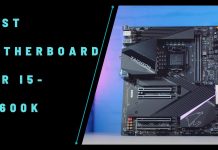Finding the best motherboard for the Ryzen 5 3600 is not a walk in the park, particularly due to the infinite options available on the market. Our review of the Ryzen 5 3600 reveals that this six-core CPU delivers excellent performance gaming performance while being relatively affordable, making it one of the best budget CPUs out today. and spot-on pricing. My testing confirms that it needs a powerful motherboard to fully stretch its wings, which is why we bring you this roundup.
Explore our comparison table to discover the best motherboards for the Ryzen 5 3600:


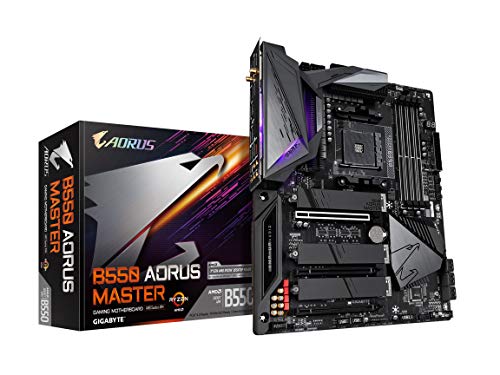









Own a Ryzen 5 3600? We’ve got the perfect guide for you:
Best Motherboards For Ryzen 5 3600
Our diligent testing has led us to compile a selection of the ultimate motherboards for the Ryzen 5 3600:
- Best X570 Motherboard For Ryzen 5 3600: ASUS ROG Strix X570-E Gaming
- Best Gaming Motherboard For Ryzen 5 3600: MSI MAG B550 Tomahawk MAX WiFi
- Best B550 Motherboard For Ryzen 5 3600: Gigabyte B550 AORUS Master
- Best Micro-ATX Motherboard For Ryzen 5 3600: ASRock B550M Steel Legend
- Best B450 Motherboard For Ryzen 5 3600: ASUS ROG Strix B450-F
- Best Value Motherboard For Ryzen 5 3600: Gigabyte B450 AORUS Pro WiFi
ASUS ROG Strix X570-E Gaming
Best X570 Motherboard For Ryzen 5 3600
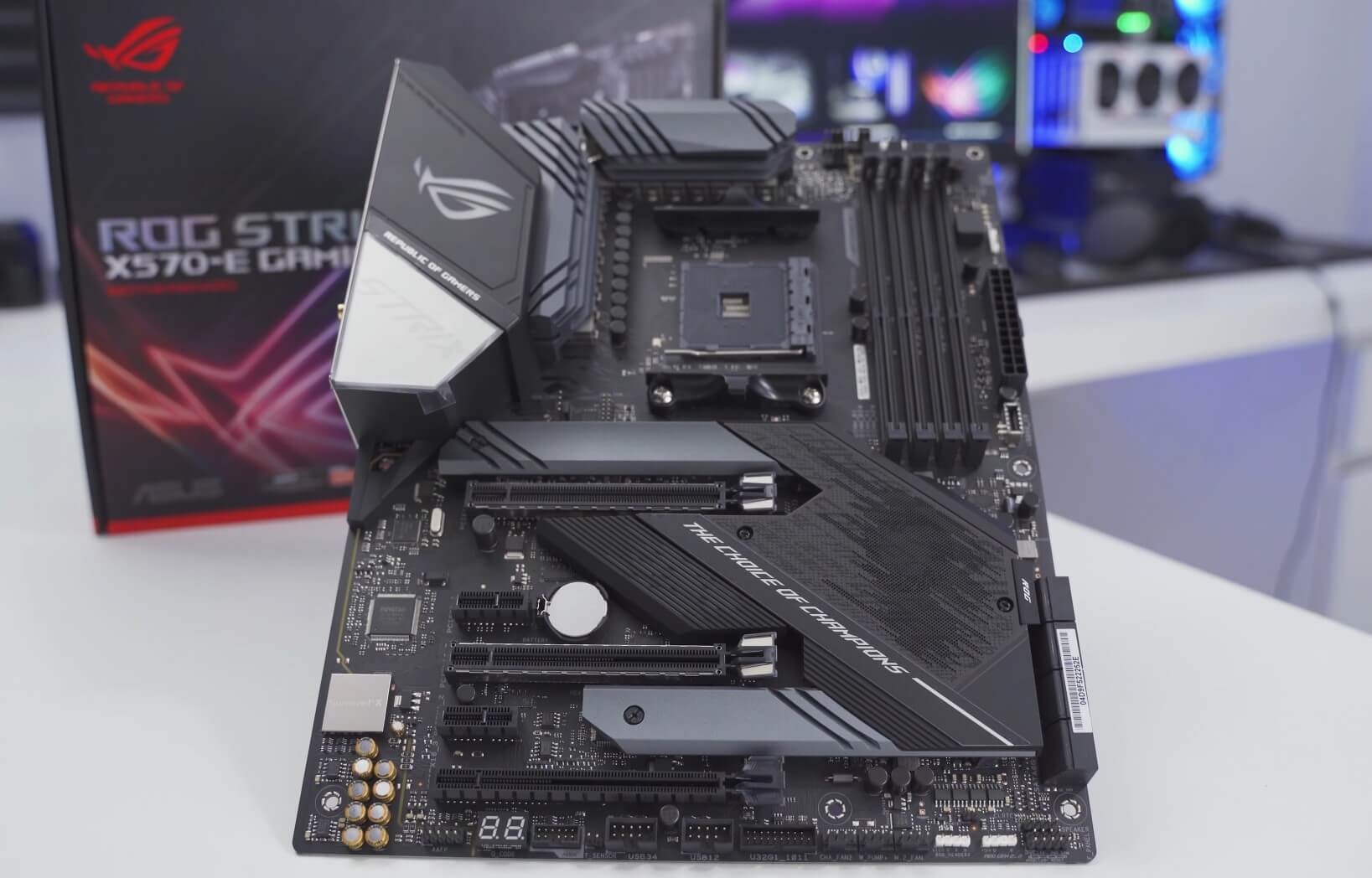
Specs= Chipset: X570 | Memory: 4x DIMM, 128GB, DDR4-5100 | Video Outputs: HDMI and DisplayPort | USB Ports: 8x rear IO, 7x internal | Network: 1x 2.5 GbE LAN, 1x Wi-Fi 6 | Storage: 2x M.2, 8x SATA
Pros
- Decent aesthetics
- Outstanding thermal efficiency
- Ample CPU overclocking headroom
- Fast LAN with onboard WiFi 6 & BT 5.0
Cons
- Comparatively overpriced
- Only 2x M.2 SSD slots
Design and Build Quality: The board features a modern and aggressive design that looks quite nice. For RGB, ASUS provides 2x Aura RGB Strip headers and a pair of Addressable Gen 2 headers for lighting, customizable via ASUS Aura Sync. A 6-layer PCB, alongside a dedicated MOS, is on display here for extra durability.
Performance: The ASUS ROG Strix X570-E Gaming sports a Digital VRM Design consisting of 12+4 power phases that culminate high-side and low-side MOSFETs and DrMOS into a singular package to deliver sustained and efficient power to the Ryzen 5 3600, according to my test results.
Features and Connectivity: The ASUS ROG Strix X570-E Gaming offers dual M.2 SSD slots, both of which are compatible with PCIe Gen 4.0. As for I/O, the ROG Strix X570-E Gaming sports 7x USB 3.2 Gen 2×1 Type-A ports accompanied by a solitary USB 3.2 Gen 2×1 10 Gb/s Type-C port, as well as WiFi 6 for wireless networking.
Buy It If:
You want PCIe 4.0 compatibility: The Strix X570-E Gaming offers PCIe 4.0 compatibility across multiple M.2 slots, providing faster data transfer speeds and support for high-performance GPUs and storage devices.
You want to overclock: According to my testing, the ROG Strix X570-E Gaming is suitable for overclocking thanks to its robust 12+4 phase VRM and excellent cooling solutions.
Don’t Buy It If:
Your budget is limited: The Strix X570-E Gaming may not be the best choice if your budget is limited, as it comes with a premium price tag, and there are more budget-friendly options available.
What Makes It The Best X570 Motherboard For Ryzen 5 3600?
The ASUS ROG Strix X570-E Gaming is undoubtedly the best X570 motherboard for Ryzen 5 3600 as it delivers best-in-class performance with a luxurious audio setup, accompanied by fantastic heat dissipation, an advanced and efficient digital power delivery system, supplemented by a chipset fan integrated into a 6-layer PCB.
| VRM Performance: 9/10 | Value: 8/10 |
| Features: 9/10 | Design: 9/10 |
MSI MAG B550 Tomahawk MAX WIFI
Best Gaming Motherboard For Ryzen 5 3600
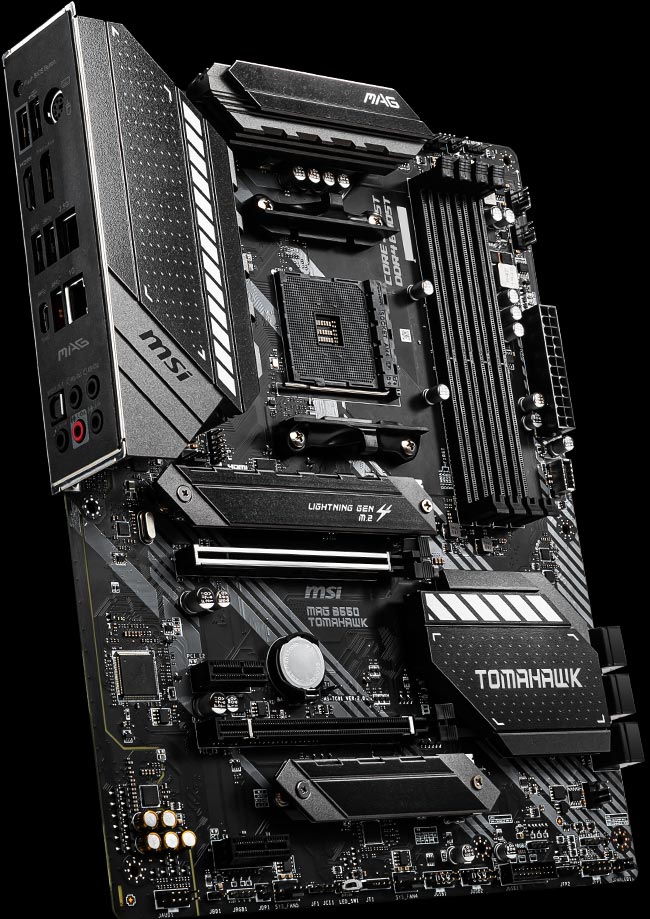
Specs= Chipset: B550 | Memory: 4x DIMM, 128 GB, DDR4-5100 | Video Outputs: DisplayPort and HDMI | USB Ports: 6x rear IO, 7x internal, | Network: 1x 2.5 GbE LAN, 1x Wifi 6E | Storage: 2x M.2, 6x SATA
Pros
- Extremely fast RAM
- 2.5 Gb LAN that assures less latency
- Wifi-6E for faster connection speeds and less latency
Cons
- Frail VRM architecture
- Less M.2 Gen4 slots
Design and Build Quality: Aesthetically, the motherboard is heaven for black theme lovers as the black PCB engulfed with black heatsinks creates a modern and good-looking motherboard. The RGB lighting below the heatsink also adds to the charm. It also packs a 6-layer 2oz PCB to provide some level of sturdiness to the setup.
Performance: The MSI MAG B550 TOMAHAWK MAX WIFI features a 10+2+1 DUET Rail power system VRM rated at 60A of current, which performed admirably in my overclocking tests with the Ryzen 5 3600. For adequate power, the motherboard gets powered by 1x 24-pin ATX main power and 1x 8-pin ATX 12V power.
Features and Connectivity: For storage, The MAG B550 TOMAHAWK comes with an M.2 Gen4 x4 64Gbps slot, an M.2 Gen3 x4 32Gbps slot, and six SATA 6Gbps ports. You won’t have many USB connectivity issues on the motherboard as it packs two USB 3.2 Gen 2 10Gbps, five USB 3.2 Gen 1 5Gbps ports, and six USB 2.0 ports.
Buy It If:
You want an excellent feature set: The B550 TOMAHAWK MAX offers an outstanding feature set, including robust connectivity options, advanced audio, and versatile I/O, making it a great choice for those seeking comprehensive functionality.
Don’t Buy It If:
You want more M.2 slots: If you require more than 2 M.2 slots for storage expansion, this motherboard may not be suitable.
What Makes It The Best Gaming Motherboard For Ryzen 5 3600?
From our testing, the MSI B550 TOMAHAWK MAX’s amazing features like the 5100 MHz+ of RAM speed, Wifi-6E, 2.5 Gb LAN port, and a PCIe 4.0 x16 slot with AMD CrossFire Technology make it the best gaming motherboard For Ryzen 5 3600.
| VRM Performance: 9/10 | Value: 8/10 |
| Features: 8/10 | Design: 7/10 |
Gigabyte B550 AORUS Master
Best B550 Motherboard For Ryzen 5 3600
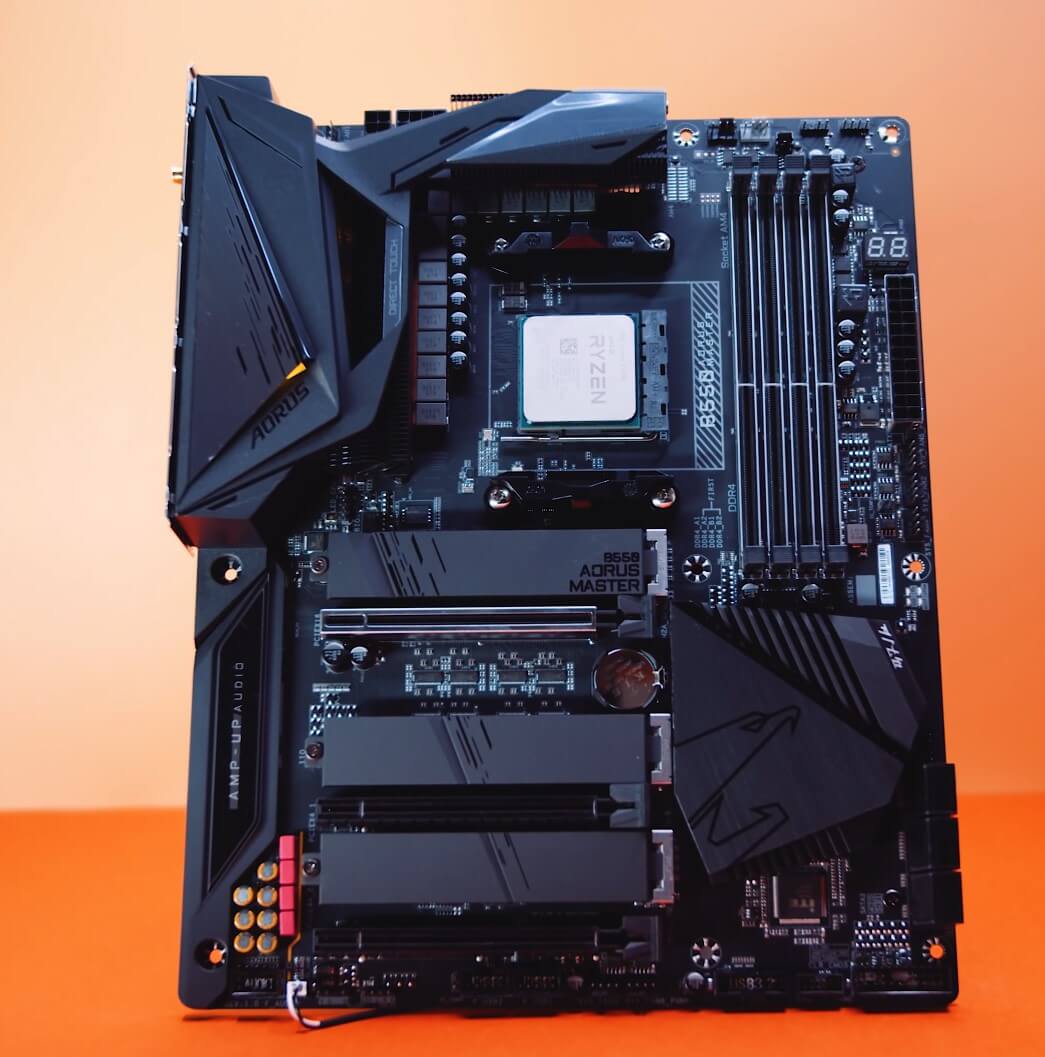
Specs= Chipset: B550 | Memory: 4x DIMM, 128GB, DDR4-5400 | Video Outputs: HDMI | USB Ports: 12x rear IO, 6x internal | Network: 1x 2.5GbE LAN, 1x WiFi 6 | Storage: 2x M.2, 6x SATA
Pros
- Efficient VRM Design
- Numerous USB Ports
- Attractive Design
- High Memory Compatibility
Cons
- Relatively Pricey
Design and Build Quality: The B550 AORUS Master features a stylish black and grey color combination. A considerable portion of the shroud uses brushed aluminum material that adds to the beauty. However, the RGB elements are limited to the shroud. In addition, a thermal baseplate adds to the overall build quality of the board.
Performance: According to my test results, the Infineon 16-phase VRM design performed admirably even while overclocking. It uses a 14+2 setting with 70A power stages that provide more than enough juice for the Ryzen 5 3600. The task of heat dissipation is primarily fulfilled by a fins-array heatsink connected to a direct-touch heatpipe.
Features and Connectivity: There are three PCIe 4.0 x4 M.2 slots with dedicated heatsinks for each. You also get six SATA3 6GBps ports that are simultaneously usable with all the M.2 slots. The rear I/O panel is loaded with a ton of connectivity options, such as 12 USB ports, including 6 USB 3.2 Gen2 (10GBps/5GBps) and six USB 2.0 ports.
Buy It If:
You want an efficient VRM design: The B550 AORUS Master boasts an efficient 14+2 phase VRM design, ensuring stable power delivery to the CPU according to my tests, especially when overclocking.
Don’t Buy It If:
You have budget constraints: If you’re on a tight budget, the B550 AORUS Master might not be the best choice, as it could be relatively more expensive compared to similar alternatives.
What Makes It The Best B550 Motherboard For Ryzen 5 3600?
All things considered, the B550 AORUS Master has an impressive feature set and a superb power delivery system which makes it the best B550 motherboard for Ryzen 5 3600.
| VRM Performance: 9/10 | Value: 8/10 |
| Features: 8/10 | Design: 8/10 |
ASRock B550M Steel Legend
Best Micro-ATX Motherboard For Ryzen 5 3600
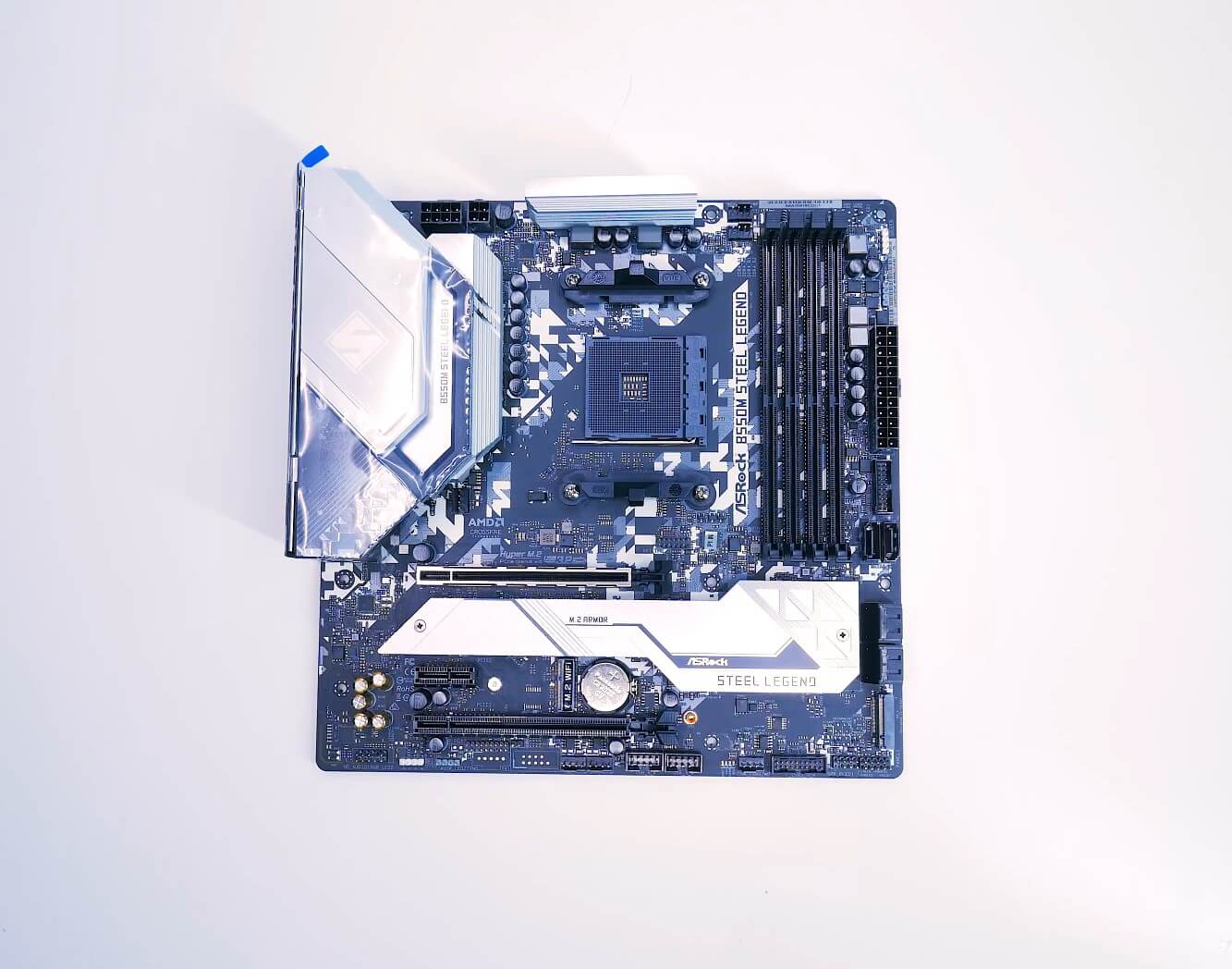
Specs= Chipset: B550 | Memory: 4x DIMM, 128GB, DDR-4733 | Video Outputs: HDMI and DisplayPort | USB Ports: 8x rear IO, 8x internal | Network: 1x 2.5GbE LAN | Storage: 2x M.2, 6x SATA
Pros
- Premium Audio Codec
- Option Of 2.5 GbE LAN
- Good Storage Options
Cons
- Controversial Looks
- No Onboard WiFi
Design and Build Quality: The ASRock B550M Steel Legend features a black PCB with a striking black and white camo pattern running across the board. The heatsinks are made out of brushed aluminum and have a premium feel to them. A touch of RGB lighting can be seen under the chipset heatsink and on the I/O cover.
Performance: The B550m Steel Legend provides smooth power delivery via the 10-phase VRM design, per my testing. The heatsinks ensure that VRMs remain stable by taking the excess heat away from the power delivery circuitry. Moreover, the chipset also remains cool courtesy of the all-in-one heatsink covering the chipset and the M.2 slot.
Features and Connectivity: For storage, the primary M.2 slot operates at PCIe Gen4 x4 speed, whereas the secondary slot supports Gen3 x2 speeds or the SATA interface. The rear I/O panel comes with a total of eight USB ports, two of which are USB 3.2 Gen2 (Type-A and Type-C), four are USB 3.2 Gen1 and the last two are USB 2.0 ports.
Buy It If:
You want a compact motherboard: The B550M Steel Legend is an excellent choice if you’re looking for a motherboard in a compact form factor, making it suitable for small PC builds with limited space.
Don’t Buy It If:
You want onboard WiFi: If built-in WiFi connectivity is a necessity for your setup, this motherboard may not be suitable, as it lacks onboard WiFi capabilities.
What Makes It The Best Micro-ATX Motherboard For Ryzen 5 3600?
The ASRock B550M Steel Legend bears an extremely reasonable price tag along with an excellent VRM setup, incredible aesthetics, and a fantastic overall feature set, making it the best Micro-ATX motherboard for Ryzen 5 3600.
| VRM Performance: 7/10 | Value: 8/10 |
| Features: 8/10 | Design: 10/10 |
ASUS ROG Strix B450-F
Best B450 Motherboard For Ryzen 5 3600
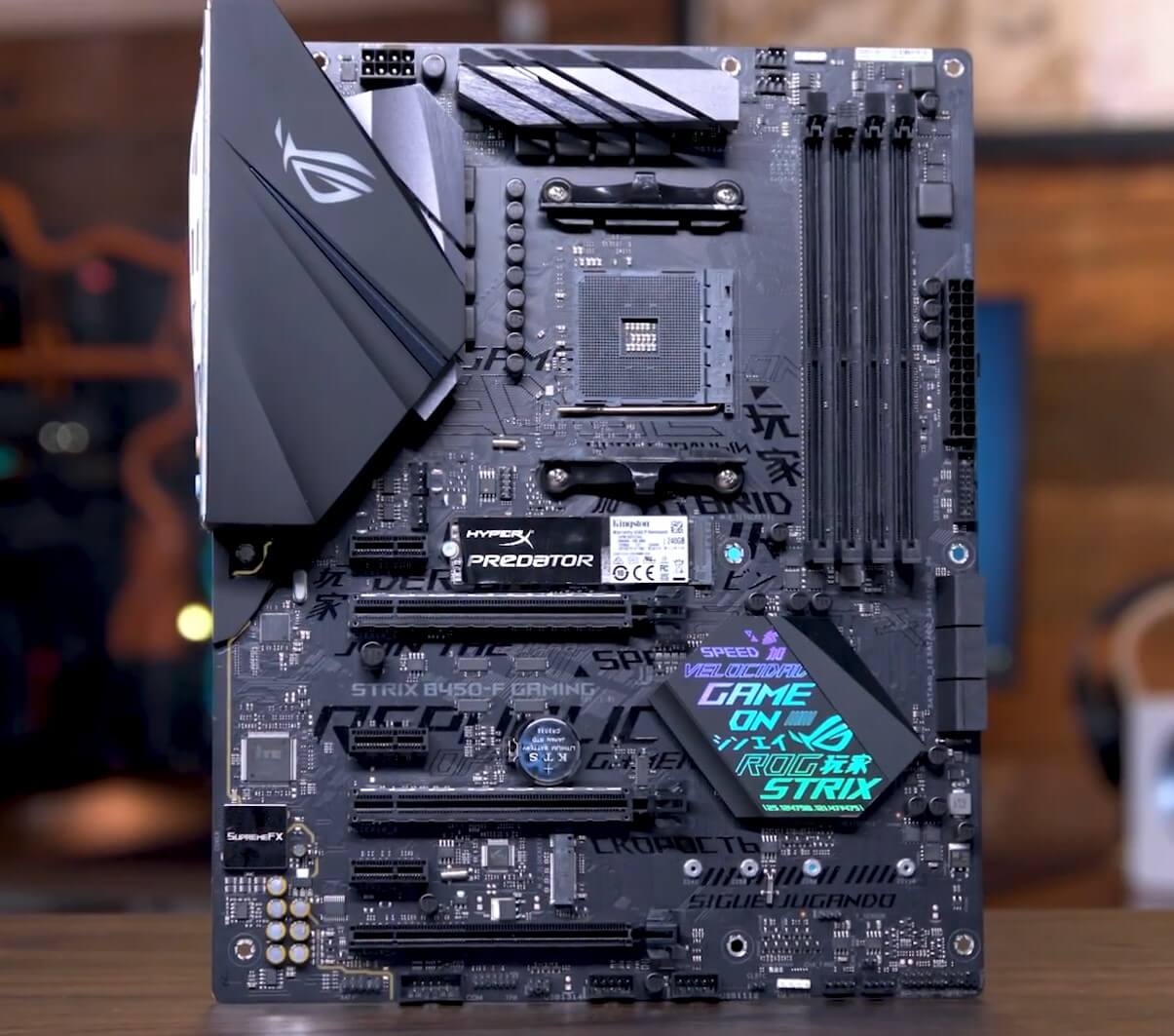
Specs= Chipset: B450 | Memory: 4x DIMM, 128GB, DDR4-3600 | Video Outputs: HDMI and DisplayPort | USB Ports: 8x rear IO, 6x internal | Network: 1x 1GbE LAN | Storage: 2x M.2, 6x SATA
Pros
- Relatively Affordable
- 2x M.2 slots
- Attractive RGB
Cons
- Mediocre VRM
- No WiFi
Design and Build Quality: The board shows remarkable aesthetics, as the PCB is entirely black with some silver text written over it. The ‘ROG’ text is prominently carved under the M.2 slot with the ROG design next to it. Apart from that, the rear I/O cover is also all-black, with a thin blue stripe and an RGB ROG logo over it.
Performance: The B450-F Gaming II makes use of an 8+4 VRM design instead of the 6+2 on the older version. Over the VRMs, there are silver-brushed metallic heatsinks to keep the thermals in check. The by-product of sturdy power delivery paired with an excellent cooling solution is impressive overclocking abilities, as validated by my testing.
Features and Connectivity: The storage department is decent, with two M.2 slots and six SATA ports to install your HDDs and SSDs. It comes with three USB 3.2 Gen2 ports, including two Type-A, whereas most boards in this category only feature two Gen2 ports. You also get two USB 2.0 ports for linking up your peripherals.
Buy It If:
You want to maximize value for money: The ROG Strix B450-F is a great option if you’re looking to get the most out of your budget, as it offers an impressive range of features and performance for its price.
Don’t Buy It If:
You want WiFi connectivity: If onboard WiFi is essential for your connectivity needs, the Strix B450-F may not be the best choice, as it does not come with built-in WiFi capabilities.
What Makes It The Best B450 Motherboard For Ryzen 5 3600?
All in all, the ASUS ROG Strix B450-F Gaming is the best B450 motherboard for Ryzen 5 3600, as it has robust power delivery and a fantastic overall feature set along with incredible aesthetics at a reasonable price point.
| VRM Performance: 7/10 | Value: 10/10 |
| Features: 7/10 | Design: 8/10 |
Gigabyte B450 AORUS Pro WiFi
Best Value Motherboard For Ryzen 5 3600
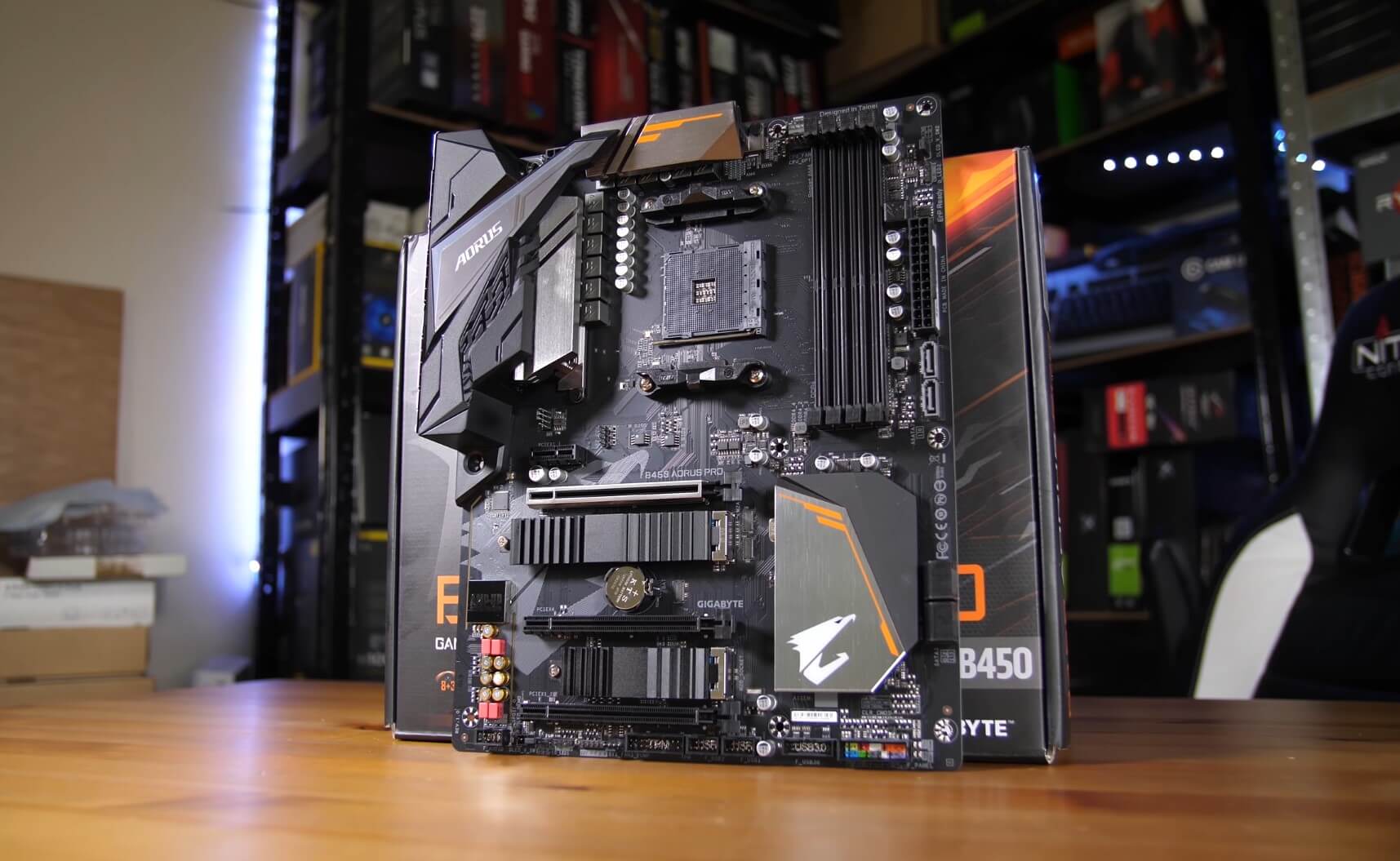
Specs= Chipset: B450 | Memory: 4x DIMM, 128GB, DDR4-3600 | Video Outputs: DVI-D and HDMI | USB Ports: 6x rear IO, 6x internal | Network: 1x 1 GbE LAN, 1x WiFi | Storage: 2x M.2, 6x SATA
Pros
- Robust CPU Power Delivery
- Attractive Aesthetics
- Inclusion Of WiFi
Cons
- Sparse USB Ports
- Low Memory Compatibility
Design and Build Quality: The B450 AORUS Pro Wifi features a clean black PCB with silver heatsinks that are styled with orange accents. For a budget motherboard, the AORUS Pro has plenty of RGB to go with it, as well as several RGB and aRGB headers. In simple words, the design is sleek and attractive and blends in quite nicely with most builds.
Performance: The power delivery is robust considering the price tag, all thanks to the 11-phase VRM arranged in an 8+3 design. Heat dissipation is carried out rather amazingly by the stylish silver-finished VRM heatsinks. In our testing, we were able to overclock the Ryzen 5 3600 up to 4.3GHz at 1.212V paired with the Cryorig R1 cooler.
Features and Connectivity: The I/O panel lacks a bit, especially in terms of USB ports. There are only six USB ports, including 2 USB 3.2 Gen2 (Type-A and Type-C) ports. There is an RJ-45 LAN port powered by Intel GbE LAN with cFosSpeed Internet Accelerator. Apart from that, there are 2 antenna connectors for Wi-Fi connectivity.
Buy It If:
You want a robust power delivery system: The Gigabyte B450 AORUS Pro WiFi is an ideal choice if you’re looking for a strong and reliable power delivery system, as this board enables stable overclocking according to my test results.
Don’t Buy It If:
You want more rear USB ports: If you require a greater number of rear USB ports for your peripherals and devices, this motherboard might not be the best fit as it offers only 6 rear USB ports.
What Makes It The Best Budget Motherboard For Ryzen 5 3600?
The Gigabyte B450 AORUS Pro WiFi is quite well-equipped and is an excellent budget option for those who do not want to pay extra for PCIe Gen 4, making it the best budget motherboard for Ryzen 5 3600.
| VRM Performance: 8/10 | Value: 10/10 |
| Features: 7/10 | Design: 8/10 |
How We Tested & Picked The Best Motherboards For Ryzen 5 3600
When buying a motherboard, be sure to look out for the following key factors.
- VRM: One of the most pivotal decisions to make in motherboard purchasing is about the VRM. We all know that every component needs a set amount of power to work. If more power is provided, the part will not function. To stop this from happening, the motherboard comprises the VRM (Voltage Regulator Module).
- Thermals: As excess voltage damages the motherboard’s components, the same is true with excess heat. In a motherboard, the PCB layers are the first thing to look for in the context of heat reduction. Heatsinks in a motherboard are also substantial because they disperse heat from the components keeping the motherboard cool.
- Expansion Slots and Connectivity: Each motherboard has specific expansion and storage slots alongside USB ports. There are multiple types of slots and ports in each motherboard. But the three most common ones are the expansion slots, storage slots, and USB ports. You should look out for the connectivity features you want from the motherboard.
- Aesthetics: Having a beautiful matching board adds to the looks of your setup. If you’re spending money on something, why not make it attractive? Nowadays, RGB lights also play a huge role in the aesthetics of a motherboard.
Frequently Asked Questions
As we have spoken about the versatility of Ryzen processors and their support for a variety of motherboards. The Ryzen 5 3600 is no exception and is compatible with almost all motherboards including B550 and X470. It can even be used with the cheap A320 motherboard.
The Ryzen 5 3600 in our opinion, offers one of the best price-to-performance ratios for any processor. You get an all-in-one package: a 6-core 12-thread layout, a mere 65W TDP, and superb gaming performance. Moreover, you also get CPU support across the line, from 300 series motherboards to the latest 500 series motherboards.
The Ryzen 5 3600 is an excellent processor for multitasking due to its 6-core and 12-thread arrangement. If you like to stream while playing games, then the 3600 is definitely a worthy option. Pair it with a suitable graphics card and it will handle your games along with streams without any lag or FPS drops.
Our testing extends to a wider array of Ryzen 3000 series motherboards:
Recent Updates
- November 5, 2023: Few text changes to improve readability. No products were changed.
Thank you! Please share your positive feedback. 🔋
How could we improve this post? Please Help us. 😔
[Casings & Motherboards Expert]
Faizan Ahmed is a Computer Hardware Specialist and professional writer covering all the ranges of different PC Casings alongside the latest Motherboards. He is the man to read when you’re buying a casing for your PC, need a Motherboard for your specific processor, or are concerned about the socket or CPU Cooler.
Having a keen eye for the details, his research includes the latest updates and technologies implemented in the sector and the quick response to approaching them ASAP. Before working on Tech4Gamers, Faizan has written immensely on freelancing platforms under the Tech niche, ranging from PC Components to different smart devices, software, and even Game Reviews and Guides.
He’s also written on websites like WhatIfGaming and Mondestuff. Faizan is an early PC gamer, and this prolonged interaction with the PC and Games has made him the perfect candidate for expressing his ideas and concepts in words for others in the community.
Get In Touch: faizan@tech4gamers.com


 Threads
Threads
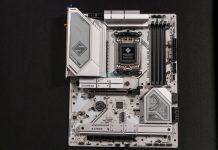
![6 BEST Motherboards For i9-13900KS [Recommended By Experts] Best Motherboards for Intel Core i9-13900KS](https://tech4gamers.com/wp-content/uploads/2023/01/Best-Motherboards-for-Intel-Core-i9-13900KS-218x150.jpg)
![6 BEST Motherboard For i9-10900k [Performance, Budget] Best Motherboard For 10900k](https://tech4gamers.com/wp-content/uploads/2022/06/Best-Motherboard-For-10900k-218x150.jpg)
